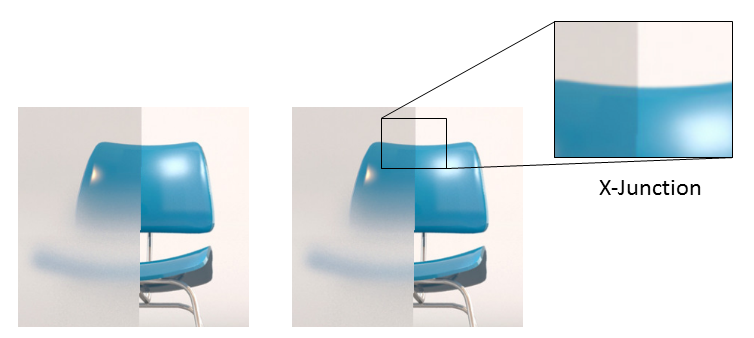Transparency Interpretation of X Junctions
Eric Saund, Ph.D.
An X-Junction occurs in an image when a semi-transparent object lies in front of an object boundary.

The chair is occluded by a semi-transparent panel. The panel gets blurry near the bottom. Here, we are concerned with the X-junction found at the clear, tinted part of the glass near the top. What about this scene makes it appear that that the tinted panel is placed in front of the chair?
This javascript app explores
the interpretation of surface lightnesses at X-junctions. The app implements a theory
for how people will interpret configurations of lighter and darker regions
as semitransparent occluding surfaces.
Psychophysicists have proposed an "atmospheric" model for surface lightness
perception. The lightness of a surface patch is interpreted as a combination
of the lightness of some underlying surface, and a contribution from an
occluding, semitransparent surface. Metelli's law states:

where
- r, s are measured patch lightnesses (0 = black, 1 = white)
- p, q are lightnesses of the background surfaces
- t is the inherent lightness of the occluding atmosphere
- alpha is the opacity of the atmosphere (0 = opaque, 1 = transparent)
Sometimes an additive term is appended to the model.
This model can be applied to X-junctions under the assumption that
some underlying contrast edge (p q) is partially occluded by a semitransparent surface
resulting in lightnesses (r s).

While the model applies to color surfaces and occluders as well, this
illustration uses color for illustrative purposes only. The demo
applet deals only with grayscale lightness.
Adelson and Anandan noted that depending on the behavior of contrast
signs as a lightness boundary is traversed through an X-junction, one of three
conditions holds: a semitransparent overlap interpretation is possible in one,
both, or neither direction. In other words, under some combinations of
lightnesses, the pair (q s), or others, could be interpreted as being
seen through an occluding semitransparent surface.
The applet
demonstrates this atmospheric model for the interpretation of transparency at
an X-junction. Depending on the relative lightnesses, a valid occluder
could be a circle, a hole, or a rectangular strip.

- Use the sliders on the right to adjust lightnesses of patches a, b, c, and
d.
- Drag the circle to provide a motion cue for a moving circle/hole object.
- The two-dimensional graphs illustrate the solutions to the Metelli
equation across the vertical and horizontal overlap directions. The left and
right graphs manipulate alternative transparent interpretations.
Moving points (a c) or (b d), in the left graph, adjusts
- background consisting of a field with a circle painted on it
- occluding surface splitting the image in two
Moving points (a b) or (c d), in the right graph, adjusts
- background consisting of a two rectangular patches
- occluding surface which is either a circle or a complete surface with a
hole cut in the middle
- Icons activate to indicate which transparent interpretations are predicted by the
atmospheric model. Compare with your own perception.
- A possible transparent interpretation is predicted when both points are on the
same side of the t-diagonal.
- The blue line shows how the lightness point pairs imply the parameters of
the atmosphere.
- The point furthest from the diagonal is the background;
the point nearer is the occluder.
- The intersection of the blue line with the t-diagonal indicates
the occluding surface's inherent lightness t.
- The position of the lightness point along the blue line indicates the
occluder's opacity alpha.
- As you adjust surface lightnesses, opacity alpha and occluding
surface lightness t are updated in the sliders at the bottom. Use
these sliders to adjust alpha and t directly. (You can also
drag t directly on the 2d graphs.)
- Points can be arranged to generate lightness combinations permitting
- no transparent interpretations (double-reversing junctions)
- one transparent interpretations (single-reversing junctions)
- two perpendicular transparent interpretations (non-reversing junctions)
Notes and Observations
- Some lightness combinations look like a spotlight shining on a dimly-lit
background.
- Some lightness combinations result in t < 0 (smoke blacker than
black) or t > 1 (fog whiter than white). These look like regular
smoke and fog to me.
- When the points are nearly parallel to the t-diagonal, it becomes
ambiguous whether the atmosphere is a region of smoke or the complementary
region filled with fog. I tend to see smoke more readily than fog.
- I tend to see the strongest transparency effects when t is in the middle
range, neither black smoke nor white fog, but intermediate grey.
- Whenever two transparent interpretations are possible, they both imply the
same underlying lightnesses t for their respective occluding surfaces.
Their opacities alpha may differ. This arises directly from the
Metelli equations. If this prediction can be shown to be violated
psychophysically it would indicate a failure of the purely multiplicative
atmospheric model.
- One way to help yourself perceive the transparency is to drag the circle
around and imagine it being either in front of both of the rectangular panels,
or sandwiched between them. Transparency interpretations are intimately
related to relative surface depth layering.
This kind of analysis will be required to extend
computational models of the perceptual organization of occluding surfaces
to images containing X-junctions, which provide cues for surface transparency.
References
- Ted
Adelson and P. Anandan, "Ordinal Characteristics of Transparency," AAAI-90
Workshop on Qualitative Vision, Boston, MA. 1990.
- Bart Anderson
, "A Theory of Illusory Lightness and Transparency in Monocular and
Binocular Images: The role of contour junctions", Perception, 26(4),
1997.
- Metelli, F., "The Perception of Transparency," Scientific
American, Vol 230, pp. 90-98, 1974.
- Saund,
E.,
"Perceptual Organization of Occluding Contours of Opaque Surfaces",
Computer Vision and Image Understanding: Special Issue on Perceptual
Organization", Vol. 76, No. 1, Oct 1999, pp. 70-82.
- Saund, E., "Toward Richer Labels for Visual Structure," in K. L. Boyer and
S. Sarkar, eds, Perceptual Organization for Artificial Vision Systems, Kluwer, 2000.




